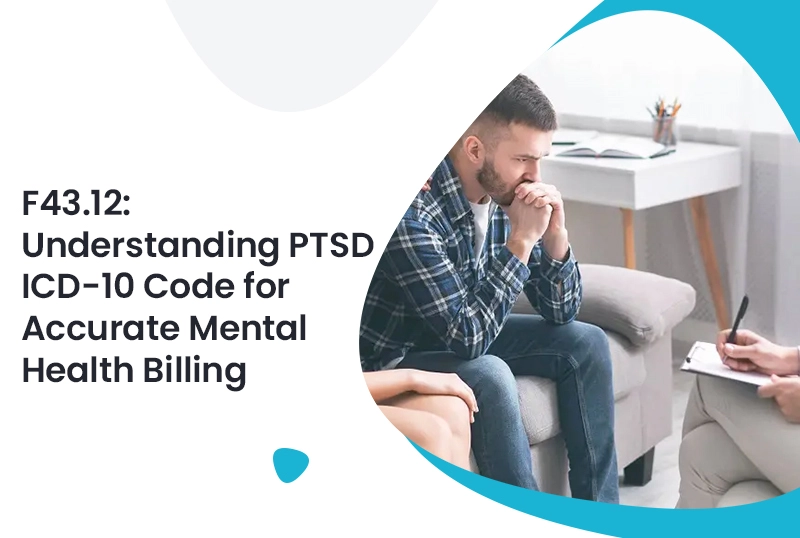If you’ve ever tried billing for post-traumatic stress disorder (PTSD) and got hit with claim denials, you’re not alone. PTSD coding isn’t just about entering “F43.12” into your system and hoping for the best. It’s about accuracy, compliance, and understanding the nuances behind the code.
F43.12 refers to Post-Traumatic Stress Disorder, Chronic, according to ICD-10-CM. It’s a diagnosis with real weight for both patients and providers. And when it comes to billing, accuracy is everything.
When you partner with a medical billing service, you’re trusting them to ensure codes like F43.12 are used correctly, modifiers are applied when needed, and all documentation supports the claim. Why? Because one small error can lead to delayed or denied reimbursement, and nobody wants that.
Let’s walk through everything you need to know.
What Does ICD-10 Code F43.12 Mean?
The ICD-10 code F43.12 is used for chronic Post-Traumatic Stress Disorder. This is different from F43.10 (unspecified PTSD) or F43.11 (acute PTSD). The chronic classification means the symptoms persist beyond three months.
Key Symptoms Include:
- Intrusive memories or flashbacks
- Emotional numbness
- Sleep disturbances
- Irritability or anger outbursts
- Avoidance behaviors
These symptoms must be clinically documented and tied to a traumatic event, natural disaster, assault, military combat, etc., to justify use of this code.
Why Accurate Coding for PTSD Matters
Think about it: PTSD is a highly sensitive condition. Coding it wrong could not only delay payment, but it could also misrepresent a patient’s entire mental health record. That’s why attention to detail matters.
Here are a few scenarios to keep in mind:
- Was the trauma work-related? If yes, the documentation might need to meet workers’ comp standards.
- Is the provider a psychologist, psychiatrist, or LCSW? Each comes with specific billing rules.
- Are there comorbid conditions like depression (F32.9) or anxiety (F41.1)? These must be coded and justified, too.
Tips for Avoiding Denials:
- Always include clinical documentation supporting the PTSD diagnosis
- Ensure the duration (acute vs. chronic) is noted
- Double-check for potential Z codes that support the context of the trauma
F43.12 Documentation Must-Haves
Let’s be honest, great documentation is the unsung hero of every clean claim. If you’re billing F43.12, here’s what must be documented in your progress notes or EHR:
- Identified traumatic event
- Duration of symptoms
- Functional impairment in work/social settings
- Treatment plan (e.g., therapy, medications)
- Patient’s response to treatment
Missing even one of these could result in rejection, especially if your notes are vague or copied and pasted.
Common Billing with PTSD
Don’t fall into these traps:
- Using unspecified PTSD codes (like F43.10) when “chronic” is documented
- Failing to update the diagnosis after 3 months if originally marked as acute
- Not attaching required documentation when billing for high-level CPT codes
- Forgetting to use Z-codes for social factors influencing mental health (e.g., Z63.5 for family disruption)
Midway through your billing cycle? It’s a good time to reassess whether your credentialing and workflows are up to date. That’s where credentialing services come in, helping you avoid eligibility mismatches and network snags that stall your revenue.
Getting Paid Faster: The RCM Perspective
Your claims shouldn’t linger in limbo. If they are, it’s time to review your revenue process from end to end.
An efficient workflow means:
- Clean claims submitted within 24-48 hours
- Automated verification of benefits
- Accurate diagnosis and procedure coding
- Timely denial management and appeals
Revenue cycle management services don’t just help you bill faster, they optimize your revenue pipeline so money flows in smoothly.
With PTSD cases like F43.12, insurance payers are often stringent about clinical accuracy and service necessity. By tightening up your RCM, you avoid unnecessary rework and speed up reimbursement.
Conclusion
PTSD billing doesn’t have to be confusing or frustrating. When you understand how F43.12 works, document with clarity, and work with the right support partners, you’ll see fewer denials and a much smoother payment process.
Precision Hub is here to guide you at every step from medical billing services to credentialing and revenue cycle management services. Mental health coding needs precision, and we’ve built a whole company around it.
FAQs
1. What is the difference between F43.10, F43.11, and F43.12?
- F43.10: PTSD, unspecified
- F43.11: PTSD, acute (less than 3 months)
- F43.12: PTSD, chronic (more than 3 months)
2. Can a therapist use F43.12 on claims?
Yes, licensed mental health professionals like LCSWs and psychologists can use it, but documentation must justify medical necessity.
3. Is prior authorization required for PTSD treatment?
Some plans may require it, especially for extended therapy sessions. Check payer rules in advance.
4. Can I bill F43.12 with other mental health codes?
Comorbidities like anxiety (F41.1) or depression (F32.9) are often present. Just make sure they are supported in the documentation.
5. Why are my PTSD claims getting denied?
Usually due to missing documentation, incorrect use of unspecified codes, or improper credentialing. A billing audit can help.







